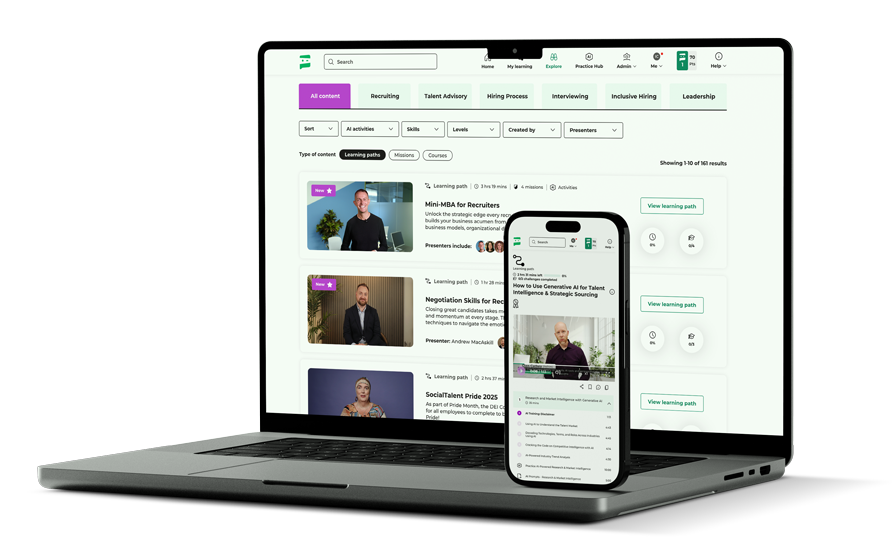
By David Deady
Since the 1950s, artificial intelligence (AI) has been a topic of more interest to academics and science fiction fans than businesses. But, in the last few years, we’ve seen the development of numerous practical applications for AI technologies, first with machine learning and deep learning, and in the last year with generative AI systems like OpenAI’s ChatGPT and Anthropic’s Claude.
The HR recruitment industry has proactively applied these technologies to candidate sourcing and recruitment automation. An estimated 88% of businesses worldwide already use AI for recruitment and sourcing in some capacity, and 79% of recruiters believe AI is or will soon be advanced enough to make hiring decisions.
Is your organization making the most of AI for recruitment and sourcing? It’s a rapidly evolving field, and recruiters on the cutting edge of AI adoption have a competitive advantage over their less technology-forward peers.
In this article, we take a quick look at the technologies underlying AI in recruitment before considering how AI can be used to automate common recruitment and sourcing tasks, the benefits of AI for recruiters, and some of the challenges and dangers of AI adoption that recruiters should be aware of.

What Is AI for Recruitment?
AI for recruitment is the application of advanced algorithms and data-driven techniques to automate various aspects of the hiring process. Recruitment AI helps recruiters and hiring managers streamline tasks and make better-informed decisions while increasing their chances of finding the best and most suitable candidates for their organizations.
AI is a broad field, but most recruitment AI solutions use machine learning and generative AI, technologies that have seen enormous advances in recent years.
Machine Learning
Machine learning, and its subfield deep learning, involve the use of algorithms that learn and improve from experience without explicit programming. Machine learning algorithms can process vast amounts of data, recognizing patterns that can be used to categorize and act on information. Email spam filters and recommendation engines on ecommerce websites often use these machine learning techniques.
In addition to human intelligence, machine learning algorithms are used in recruitment and candidate sourcing to analyze historical candidate data, to identify patterns and predict outcomes, such as candidate success in a role or cultural fit within an organization.
Generative AI
Generative AI focuses on creating new data based on existing information. Large language models (LLM) like OpenAI’s GPT-3.5 and GPT-4, which power ChatGPT, are a type of generative AI. They can understand and generate human-readable text at scale, making them useful for tasks ranging from categorization and sentiment analysis to personalization and content production.
In recruitment, generative AI can assist recruiting professionals in creating job descriptions, personalized emails, and targeted job advertisements. This can help recruiters produce highly relevant content tailored to specific candidates, thereby enhancing the overall candidate experience and increasing the likelihood of attracting top talent.
Learn more: How to Build the Perfect Candidate Experience
Why Invest in AI-Powered Recruitment and Sourcing?
AI-powered recruitment and sourcing offer numerous advantages to both recruiters and candidates. Let’s explore why AI has become so prevalent in the recruitment industry:
Time-saving:
Automating high-volume tasks allows recruiters to manage more responsibilities and focus on strategic work instead of repetitive and relatively low-value tasks. Increased efficiency accelerates recruitment and leads to quicker, more effective hires.
Improved Candidate Screening:
AI makes it possible to carry out comprehensive evaluations of potential hires quickly. An AI-aided, data-driven approach refines the screening process, resulting in better-suited candidate selections.
Bias Removal:
AI-powered recruitment tools promote workplace diversity by making the selection process more objective and reducing the influence of human bias. Candidates are evaluated on their merits and qualifications, generally increasing the likelihood of a fair assessment.
Enhanced Interactivity and Transparency:
Candidates feel more engaged and informed throughout the recruitment process, while at the same time, recruiters expend less of their work-day nurturing candidates.
Lower Cost Per Hire:
The overall cost per hire is reduced when AI streamlines the recruitment process, saving time and resources that can be allocated to other critical aspects of the business, such as employee training and development.
Identify Top Talent:
The advanced algorithms of AI-powered tools can analyze and predict the likelihood of candidate success in a given role, significantly increasing the chances of hiring the best talent available and ensuring a more effective hiring decision.
Incorporating AI technologies into the hiring and recruiting process significantly improves the candidate experience, which in turn positively impacts the hiring rates of top talent. Through personalized content, streamlined communication, and efficient processes, AI creates a satisfying and cohesive journey for job seekers. This enhanced experience not only boosts employer branding, but also strengthens the company’s ability to attract and recruit the best candidates in the future.

Recruitment Automation with Artificial Intelligence
The key benefit of AI is that it allows recruiters to automate tasks that would otherwise be time-consuming and error-prone. Let’s look at some areas of recruiting technology where AI automation is already helping recruiters be more effective.
Candidate Sourcing
AI technology empowers recruiters to analyze candidate profiles from various online sources and create personalized, highly targeted outreach efforts to qualified candidates. AI-powered tools like Fetcher can make recruiters spend efficiently identify and engage both active and passive candidates, significantly expanding the talent pool available to recruiters.
Candidate Screening
AI screening tools like HireVue can rapidly analyze large volumes of resumes, matching applicants’ experiences and skills with job requirements. Machine learning algorithms can predict candidates’ success in a role, leading to better hiring decisions.
Additionally, AI can screen candidates based on job performance or on pre-defined criteria or analyze successful employees’ experiences to more suitable candidates and refine the screening process to evaluate candidates further, saving recruiters valuable time.
Scheduling
AI-driven tools, including chatbots and calendar integrations, simplify coordinating interviews and meetings, reducing time-consuming manual tasks by allowing candidates and recruiters to select convenient time slots. Scheduling tools eliminate tedious back-and-forth communication, letting both parties focus on what truly matters.
Content Generation
Text generation tools can automate many aspects of content writing in recruitment. They aren’t a substitute for writers and editors, but can work alongside recruiters to streamline content production workflows.
You might use ChatGPT to analyze job descriptions in recruiting software and suggest improvements, making job ads more inclusive, engaging, and appealing to a broader talent pool. Crafting better job descriptions screening resumes and marketing materials helps companies attract higher-quality candidates more aligned with their values and culture.
Candidate Engagement and Nurturing
AI-powered chatbots provide round-the-clock access to interactive chats that can answer frequently asked questions, help candidates with application and interview requirements, and handle many other aspects of the recruitment process that would otherwise consume much of the recruiter’s time.
Chatbots can also be used as part of the screening process to quickly assess potential candidates’’ eligibility by asking screening questions about necessary qualifications. For an example of a service taking this approach, look at Paradox.
Digital Interviewing
AI-based video interview software assesses candidates’ word choices, speech patterns, and facial expressions, helping determine their fit for the position and company culture. These digital interviews can also help to assess candidates soft skills, especially when recruiting remote workers.
AI for Recruitment is a Must
AI for recruitment is a rapidly advancing field, providing tools that increase recruiters’ productivity, efficiency, and effectiveness. However, AI cannot replace skilled and experienced recruitment professionals. Any company that needs to hire the right people quickly needs a well-trained recruitment team.
SocialTalent’s Learning Experience Platform has helped thousands of recruiters and business leaders develop the skills needed to make talent acquisition drive their companies toward success. We offer a wide range of training courses, including:
- Recruitment & Recruiter Training
- Interviewing & Interviewer Training
- DEI Training
- Onboarding Training Course
- Leadership Training Course
Talk to a recruitment training advisor today to learn more about how SocialTalent can help your business take its recruiting to new heights.


